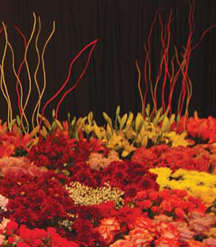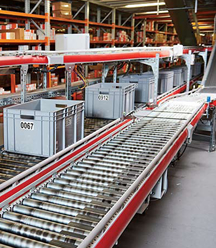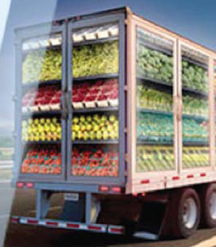Featured Past Articles
In my line of work I visit hundreds of flower farms a year; the flourishing, the ticking over, and the ones in dire straits. A lot of my hard work is dealing with farms that suddenly run into problems. “Ruth, please come and visit our farm as soon as possible, our production has suddenly dropped to half” is a common call..
By Ruth Vaughan
 My advice to flower farmers on the critical issues in plant nutrition in floriculture would be as follows:-
My advice to flower farmers on the critical issues in plant nutrition in floriculture would be as follows:-
Start With The Basics
Start with the basics and know what you are dealing with. A solid ‘risk’ assessment before you even buy the farm is recommended. Dig soil pits to look for soil layers, compaction zones, soil depth, underground water or solid rock. Is the soil type even across the farm? Where does the water go when it rains? Does it hail in this area? What are the day/ night temperatures and what is the annual rainfall? Look at the aspect and slope of the farm, will you need special drip lines? Do a complete soil analysis, nematode count, pathology screen and irrigation water analysis. Now you know what you are dealing with and can work out the economics. It’s better to get a shock now than after your investment.
Read more: Critical Issues In Plant Nutrition In Floriculture

It is the dream of every farmer to export their produce for higher returns. However, many face phytosanitary and technical challenges that lead to rejection of their produce by exporters.
For some time now, Kenya Plant Health Inspectorate Services (Kephis) has been sensitising farmers on what is needed in the export market. James Wahome, General Manager, Phytosanitary Services at Kephis spoke of one pest, False Codling Moth (Thaumatotibia leucotreta) that can stop farmers from exporting their produce.
False codling moth (FCM) hit flowers by close to 10% which led to some interceptions in the market, tainting the image of the country. KEPHIS have urged all growers to adopt more traps to ensure mass trappings of pests which are climate oriented. The players in the industry resolved to involve IPMs manufacturing companies when dealing with specific markets that are sensitive to various pests.
This is a major pest, because the larvae of the moth feeds on a wide range of rose varieties. Lately it is also becoming an issue in in gypsophilla. The brown insect originated from Sub- Saharan Africa, but has also been detected in Europe and US. It thrives under warm and humid conditions and can produce up to five generations annually.

Flowers contain a waterway system (xylem) consisting of capillaries. These capillaries act like straws that carry water and nutrients throughout the flower. This important process is called “hydration.” You can’t underestimate the value of proper hydration to the life of fresh cut flowers. A flower dehydrated during postharvest shipping needs a jump-start of water and nutrients. It’s a process with many moving parts! So, to help you achieve optimal results,Consider the following care and handling advice:
Sanitation
The importance of cleanliness is often underestimated. Research has shown that dirty buckets can reduce the vase life of a rose by up to 20%. Make sure that everything – buckets, cutters, coolers, benches, and so on – is cleaned with an approved disinfectant cleaner.
Variety knowledge
Varieties differ! Not all red roses, for example, enjoy the same vase life. Some bloom differently, and some may absorb water and nutrition differently. The consumer typically has no clue, but the consequences of buying the “wrong” flower that fails to meet expectations are well known: customer dissatisfaction, loss of business, and negative word of mouth. So, familiarize yourself with the characteristics of the flowers you offer, hydrate accordingly, and educate your customers on proper hydration practices.
 This year’s Valentines Day and mother’s Day million’s of consumer’s bought flowers. It’s peak for florists, anticipating to bring billions of dollars to the floral market.
This year’s Valentines Day and mother’s Day million’s of consumer’s bought flowers. It’s peak for florists, anticipating to bring billions of dollars to the floral market.
While it’s easy for customers to pick up flowers at the local grocery store, florist shop or to seamlessly order arrangements online, not surprisingly there’s up to a year of forecasting and planning for what one representative from online flower delivery company calls a “last-minute holiday.”
Don’t underestimate the importance of these days to the floral industry. The biggest floral holidays are Valentine’s Day and Mother’s Day, but Valentine’s Day is a big percentage of yearly sales.
High volume, perishable products, fickle winter weather and long transportation routes means that the supply chain must be working smoothly to get the fresh flowers in the customers’ hands at the right time.
The cold chain
Lovebirds around the world can thank the cold chain for allowing them to adorn their tables with blooming buds every February, and actually all year round. That’s because most of the flowers sold come from abroad. The main domestic floral producers, accounts for only a small percentage of the flowers, though these flowers too must be maintained in the proper environment for quality purposes. The rest of the flowers primarily come from South America and Africa.
Read more: The Hidden Supply Chain Behind Valentine’s Day Flowers
 IFTEX has traditionally been a very popular exhibition to market your products, services and business. With advances in social media marketing and Internet technology, like webinars, Google hangouts and video conferencing, the value and benefits of marketing via trade fair comes up. Though technology is changing marketing at a rapid pace, there are several benefits from having exhibit presence at a trade show. These six key benefits are why your business must have IFTEX Exhibition marketing presence:
IFTEX has traditionally been a very popular exhibition to market your products, services and business. With advances in social media marketing and Internet technology, like webinars, Google hangouts and video conferencing, the value and benefits of marketing via trade fair comes up. Though technology is changing marketing at a rapid pace, there are several benefits from having exhibit presence at a trade show. These six key benefits are why your business must have IFTEX Exhibition marketing presence:
1.IFTEX Creates Lasting Impressions If Done Right
The main purpose of IFTEX is to showcase a wide variety of options for attendees and business to engage and interact with each other. With a well-designed trade show booth that draws attendees’ attention, a few promotional items, a contest opportunity with giveaways and sales collateral, you will have a well-rounded booth experience that leaves an impression with a prospective customer for months. Consider having attendees enter a drawing by submitting a business card or completing an action on social media. These types of promotions serve dual purposes: increasing engagement and capturing potential contact information as well.
Read more: Six Key Benefits IFTEX Show Has to Market Your Business
The Seven Critical Steps To a Successful Warehouse Automation
Retailers are turning their attentions to warehouse automation. The reasons may be all too apparent, but the path to a successful project is not so obvious, writes Neil Adcock.
 Why are omnichannel retailers suddenly taking an interest in automating their warehouses? Until very recently the retail sector had tended to shy away from making such investments, preferring instead to take on a large labour force to manually process orders. However, that thinking appears to be changing – and rapidly so.
Why are omnichannel retailers suddenly taking an interest in automating their warehouses? Until very recently the retail sector had tended to shy away from making such investments, preferring instead to take on a large labour force to manually process orders. However, that thinking appears to be changing – and rapidly so.
A number of leading retail brands are now actively engaged in adopting high levels of automation. The reasons are clear to see, but the right approach needs to be taken if agility and operational performance are to be leveraged to full advantage.
Several significant factors have come into play to alter the balance between the use of man or machine. Firstly, shoppers are shifting online in a big way. The Office for National Statistics estimate that consumers spent £1bn a week with UK online retailers, up 20.7 percent. Internet shopping now accounts for 15.3 percent of all retail spending.
This massive and continuing growth in online purchases, with its requirement for single item picking, packing and dispatch, as well as increasing SKU proliferation, has placed a huge strain on finite labour resources in the all-important logistics hot spots. Even outside these areas, the pool of available labour is diminishing fast. The introduction of the National Living Wage has also significantly increased costs for highly staffed operations.
Brexit is another factor weighing heavily on the minds of those managing labour intensive operations. The big question is, will the availability of cheap labour from Europe ebb away in the wake of tighter border controls and the lacklustre appeal of a weaker currency? Then there are the competitive pressures within the market place.
Read more: The seven Critical Steps To a Successful Warehouse Automation
By Luke Gowdy
 It bothers me that poor cold chain management leads to so much fresh produce being thrown out before it even hits the shelf. During a Supply Chain Conference presentation, It was explained that it doesn’t have to be that way. You can use these 6 key concepts to build a better cold chain and reduce waste.
It bothers me that poor cold chain management leads to so much fresh produce being thrown out before it even hits the shelf. During a Supply Chain Conference presentation, It was explained that it doesn’t have to be that way. You can use these 6 key concepts to build a better cold chain and reduce waste.
1. Secure the right expertise
Cold chains require trained temperature controlled specialists even before the product is picked up. Specialists who understand both temperature requirements of the shipment and who have a strong working relationship with the shipper and carrier can help balance unattractive load qualities like multi-pick, multi-stop loads by filling empty backhauls.
2. Determine capacity requirements
Whether transporting temperature sensitive goods by road, ocean, air, or rail, you’ll need to carefully consider the pros, cons, and price—especially when coordinating across multiple types of transportation. Some commodities—those with higher price points—can benefit from a more expensive, yet faster shipping option.
3. Set clear expectations early in the process
If a trailer’s temperature increases by only 2 degrees Fahrenheit, it can reduce produce shelf life by as much as 50%. That’s why the shipper, carrier, vendor, provider, and other key stakeholders must agree on their roles—from acceptable temperature ranges and continuous temperature versus cycle settings, to proper seals, contingency plans, equipment expectations, and processes for returns and rejections.


